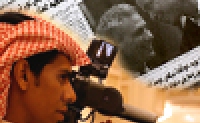Media Framing in the Middle East
Research Manager:
Craig Hayden
Project Overview
How does media representation, examined as news media "frames" or "stories,” contribute to persistent unfavorable reaction in the Middle East to United States policies and create enduring expectations about the motivations of the United States? There is an intuitive sense that media does impact audience opinions, and put constraints on public reaction to U.S. policies in the Middle East. One need only look to U.S. government reactions to Middle East television networks like Al-Jazeera and Al-Arabiya to recognize that policy-makers believe the media have a hand in influencing audiences. Polling data and traditional content analyses, however, tell only part of the story of what media might actually be doing to and for audiences in the Middle East. Rather than assume that audiences are simply media "targets," media may be a crucial site for the investigation of political discourse and a reflection of emergent sites of public argument.
This project is an ongoing investigation into the development of public argument in Arab media around key issues that have defined the representation of the United States in the Middle East since September 11, 2001. “Public argument” in this case connotes both the implicit preferred depictions contained in media frames and narratives about the United States, as well as argument practices by Arab and Middle East media audiences as observed in participatory online forums.
Objectives
The Media Framing in the Middle East project aims to provide an assessment of the consistent thematic and narrative depictions of the United States (or media frames) within various Middle East media outlets as well as suggest the development of public argument within these media venues. The goal of this project is to assess how media frames reflect a kind of argumentative discourse that contains the terminologies and characterizations which describe the United States – framing choices that may limit how the United States can be perceived. Understanding the repertoire of images, frames, and arguments in Arab media is considered crucial to both assessing the role of media in sustaining conflict, and, as necessary knowledge to construct more informed public diplomacy and other communication intervention strategies.
Associated Projects
Framing Guantanamo, Abu-Ghraib, and the Lebanon War:
A series of content analyses of pan-Arab media coverage is conducted, both in news and op-ed articles, of how meaning is developed in the context of the media frame about the United States. In particular, how is evidence consistently deployed to piece together credible depictions of the United States, which over time establishes common-sensical narratives about the U.S. across outlets. The persistent framing strategies, viewed as argument practices, are considered serious obstacles to international communication and public diplomacy. Understanding the argumentative resources within media frames should provide valuable reference points for respectful and informed communication and media-based advocacy.
Framing the U.S. Election and An Obama Presidency: Arab New Media in 2008-09:
A series of content analyses is underway of pan-Arab media coverage, both in news and op-ed articles, of the lengthy U.S. Presidential election, which resulted in the election of Barack Obama.
Iran, Arab Governments, and the United States:
This project focuses on the developing discourse over Iran’s rise to regional hegemonic status, as evidenced in pan-Arab news media. Analysis reveals the ambivalent reaction to Iranian preeminence in the Arab press, showing critical fault-lines in public debate.
New Media Argument in the Arab World:
This on-going project examines the practices of public argument evidenced in both blog and news media websites. Particular focus is on how media audiences consider, debate, and communicate opinions about news articles – as evidenced in “comments” sections of pan-Arab news websites. This kind of analysis contrasts the content analysis of previous framing in news media, with how these frames are actually re-deployed and debated by media audiences opting to go online and discuss news pertaining to coverage of the United States.








